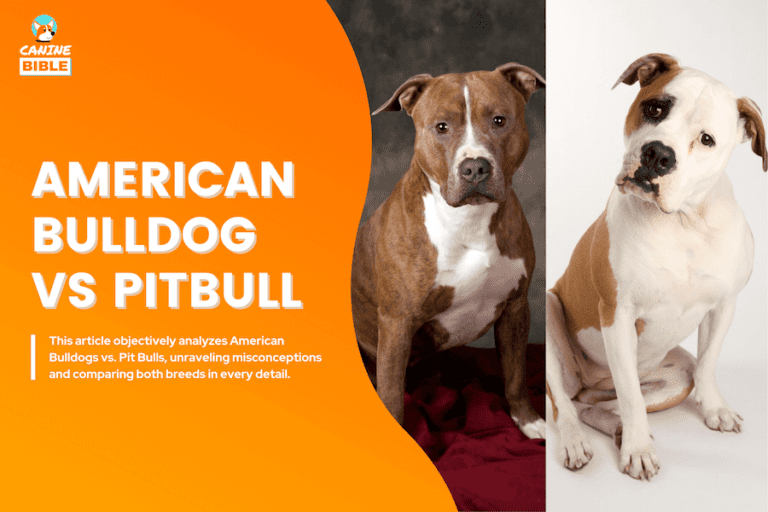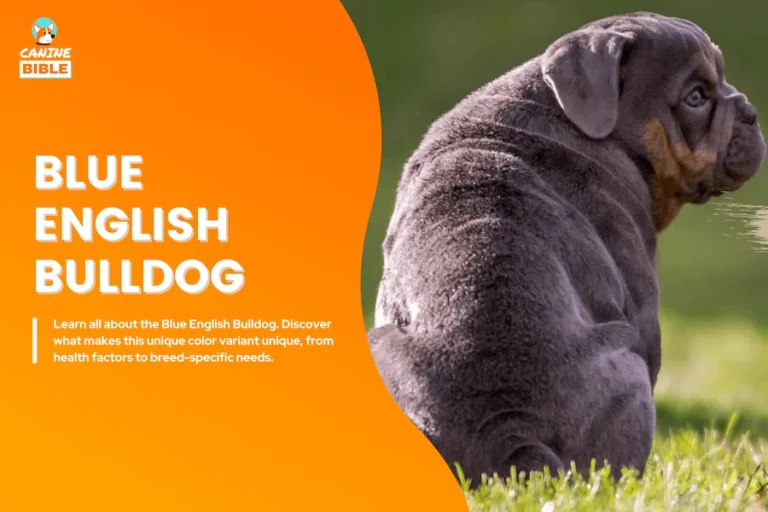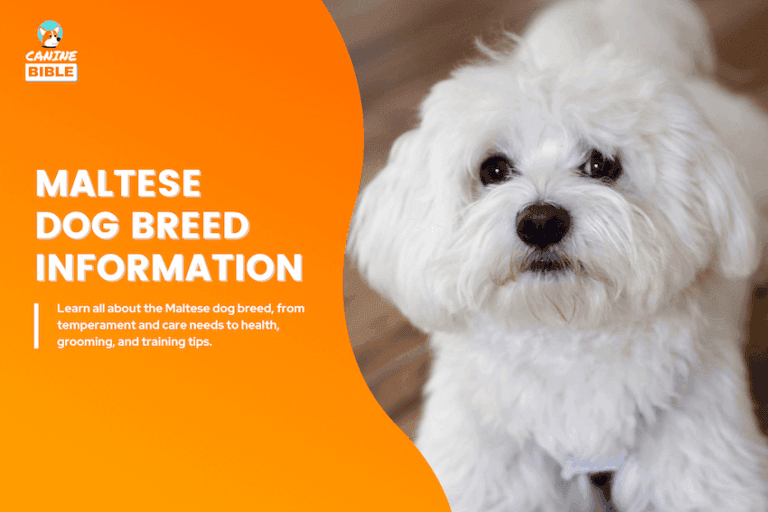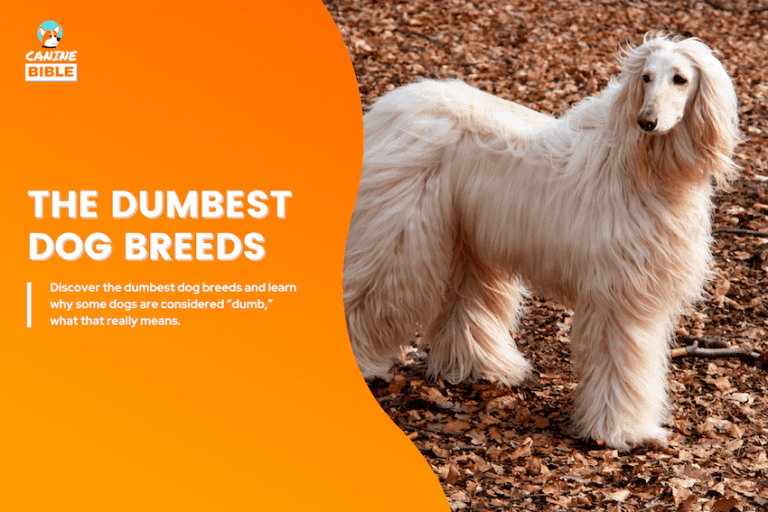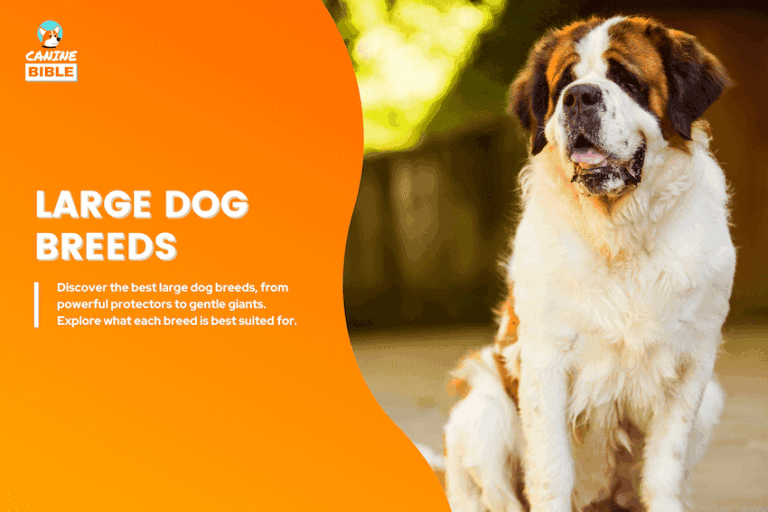Cane Corso Dog Breed Information: Traits, Facts, Care & More
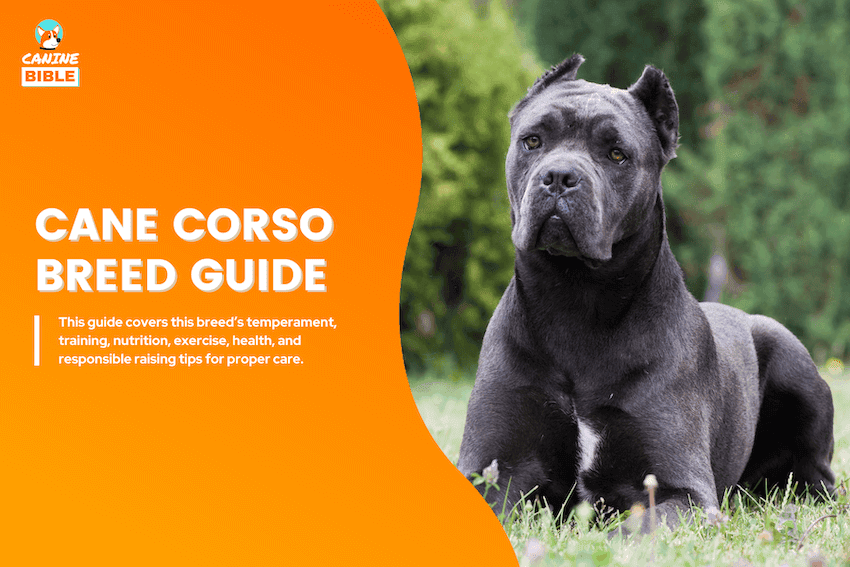
Canine Bible is reader-supported. We receive affiliate commissions via some of our links. Learn more.
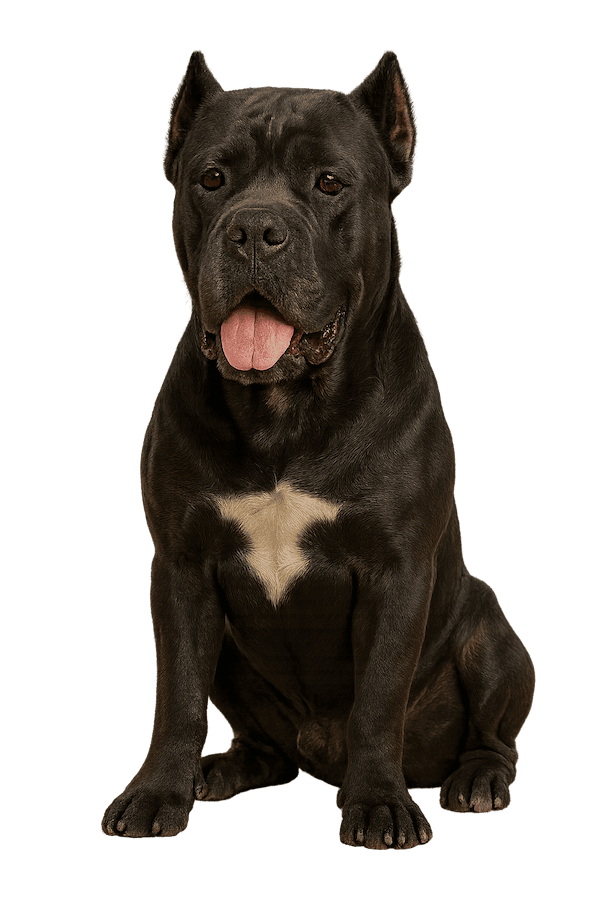
Cane Corso
Cane Corsos are powerful, intelligent, and loyal working dogs known for their muscular build and protective instincts wrapped in a calm, confident demeanor. Originally bred in Italy to guard property and hunt large game, today’s Cane Corsos thrive as devoted companions and vigilant watchdogs. Despite their large size, they possess a steady temperament and an affectionate nature that keeps them closely bonded with their families. Cane Corsos form strong connections with their owners and enjoy purposeful activities and training. They adapt well to spacious homes with secure yards but need daily exercise, structure, and socialization to stay balanced and well-mannered. These noble guardians make excellent pets for experienced individuals and families who want a large dog with a loyal heart and a commanding presence.
- Breed popularity ranking: 32 of 202
- Club: Cane Corso Association of America
- Population: 100,000+ (estimated in the U.S.)
- Price: $1,500 – $3,000
Weight
90–120 lbs
Height
23.5–27.5 inches
Lifespan
9–12 years
Breed Group
Working Group
Cane Corso Growth Chart
History and Origin
The Cane Corso, a powerful and noble working breed known for its protective instincts and intelligence, traces its origins to ancient Italy, where it descended from Roman war dogs known as Canis Pugnax. These mastiff-type dogs were used in battle and later evolved into versatile farm and guard dogs throughout the Italian countryside. Bred to protect property, livestock, and families, Cane Corsos were valued for their strength, loyalty, and intimidating presence.
Historically, Cane Corsos were trusted as guardians and hunters of large game like wild boar. Their courage, athleticism, and unwavering devotion made them indispensable working partners for Italian farmers and rural families.
The breed nearly vanished by the mid-20th century due to industrialization and war, but was revived through dedicated breeding efforts in the 1970s. The Cane Corso gained official recognition by the American Kennel Club (AKC) in 2010. Today, they are cherished for their loyalty, trainability, and regal presence, continuing their legacy as reliable protectors and devoted family companions.
Appearance
| Feature | Description |
|---|---|
| Body Build | Large, muscular, and powerful with a strong and athletic frame |
| Coat Type | Short, dense, and coarse with a light undercoat |
| Coat Colors | Black, gray, fawn, red, brindle; may have a black or gray mask |
| Facial Markings | Often features a dark mask; strong, well-defined face |
| Chest Markings | May have a small white patch on the chest |
| Tail | Thick at the base, typically docked at the fourth vertebra (where allowed) |
| Ears | Naturally dropped and triangular; sometimes cropped (where legal) |
| Eyes | Medium-sized, oval, and dark-colored with an alert, confident expression |
| Nose | Large and black with well-opened nostrils |
| Feet | Cat-like, compact, and firm with strong, arched toes |
| Overall Expression | Confident, noble, and imposing with a protective nature |
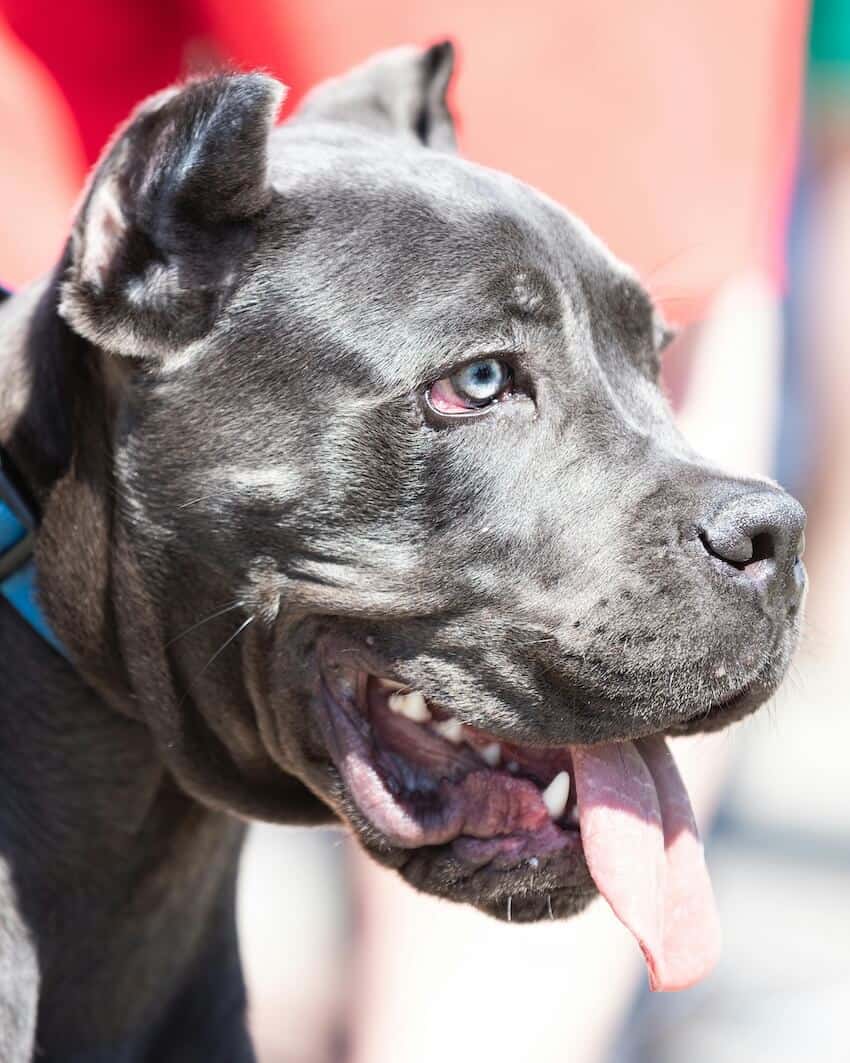
Cane Corso Characteristics
The further out a point is along a spoke, the stronger that trait is in the breed (on a scale of 1 to 10).
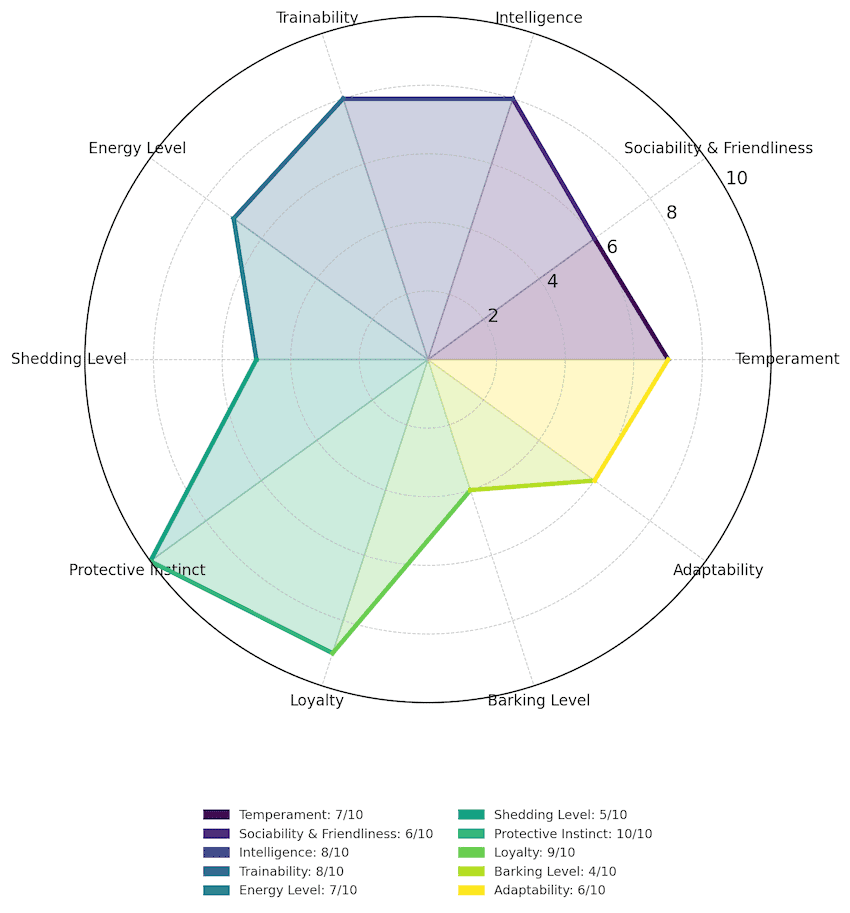
| Trait | Score | Description |
|---|---|---|
| Temperament | 7 | Even-tempered, calm, and stable. Cane Corsos are confident and assertive without being aggressive when properly trained. |
| Sociability & Friendliness | 6 | Reserved with strangers but devoted to family. Early socialization is crucial for balanced behavior. |
| Intelligence | 8 | Highly intelligent and quick to learn, though they require firm, consistent leadership. |
| Trainability | 8 | Very trainable with the right handler. Responds best to firm but positive reinforcement. |
| Energy Level | 7 | Moderately active. Needs regular exercise to stay fit and mentally stimulated. |
| Shedding Level | 5 | Low to moderate shedders with short, dense coats that require minimal grooming. |
| Protective Instinct | 10 | Extremely protective and naturally watchful. Bred to guard property and family. |
| Loyalty | 9 | Deeply loyal to their family, often forming a strong bond with one primary person. |
| Barking Level | 4 | Generally quiet but will bark when alerting or if something is amiss. Not a nuisance barker. |
| Adaptability | 6 | Adapts well to rural or suburban environments. Less ideal for small apartments without outdoor access. |
Exercise & Activity Breakdown
Cane Corsos are athletic and alert working dogs with a confident, focused nature. While they don’t require constant activity, they do need regular exercise and mental engagement to stay balanced and prevent undesirable behaviors such as restlessness, destructiveness, or overprotectiveness.
- Puppy (0–12 months): During this stage, Cane Corso puppies benefit from controlled socialization, foundational obedience training, and short play sessions. Activities like leash training, gentle tug games, interactive games, and exposure to new environments help build confidence and stability.
- Adult (1–6 years): Adult Cane Corsos thrive on structured walks, advanced obedience work, and physically demanding activities such as protection training, agility drills, weight pulling, or canine sports. Mental stimulation through tracking games and task-based play is key to keeping them fulfilled.
- Senior (7+ years): As they age, Cane Corsos may become less active but still need regular walks, light training sessions, and mental challenges to maintain joint health and cognitive sharpness. A predictable routine helps reduce stress and supports their emotional well-being.
Cane Corso Daily Activity Breakdown
Nutrition
Cane Corsos need a high-quality diet that aligns with their life stage (e.g., puppy, adult, senior). As a large, muscular breed with steady energy demands, it’s important to feed them food specifically formulated for large or giant breed dogs to support healthy growth, joint function, and overall body condition.
These diets should include balanced nutrients to maintain muscle mass, joint health, skin condition, and immune strength. Because Cane Corsos are prone to hip and elbow dysplasia, bloat, and weight gain if overfed, portion control and large-breed-specific formulas are critical. As they age, a diet rich in omega-3s, antioxidants, and joint-supporting nutrients like glucosamine and chondroitin can help manage inflammation and mobility. Read our “Best Cane Corso Dog Food Guide” to explore breed-specific nutrition tips and top food recommendations.
Nutritional Breakdown by Activity Level for Cane Corso
Common Health Issues
Most Cane Corsos are healthy, but like all dogs, they can be prone to certain health conditions. Common health concerns include:
Recommended Health Tests for Cane Corsos:
Proactive health measures, attentive care, and regular veterinary visits can help ensure your Cane Corso lives a happy and healthy life as your loyal companion.
💡 Due to this breed’s high proclivity to health issues, we recommend getting pet insurance for financial protection against unexpected medical emergencies, ensuring your pet receives the best possible care without the burden of high out-of-pocket expenses. Check out our best pet insurance guide to find a suitable plan for your pet.
Care Requirements
| Grooming Task | Recommended Frequency | Importance | Tools Needed | Recommended Product |
|---|---|---|---|---|
| Brushing | 1–2 times per week | Prevents mats and tangles, removes loose fur, and promotes healthy skin | Slicker brush, de-shedding tool, grooming mitt | Hertzko Self Cleaning Slicker Dog Brush (View on Amazon) |
| Bathing | Every 6–8 weeks | Keeps coat clean, reduces odor, and helps control shedding | dog-safe shampoo, conditioner, towel, hair dryer (optional) | OUAI Fur Bébé Pet Shampoo (View on Amazon) |
| Nail Trimming | Every 3–4 weeks | Prevents overgrowth, pain, and potential injury while walking | dog nail clippers, nail grinder, styptic powder | Coastal Pet Safari Nail Clipper (View on Amazon) |
| Ear Cleaning | Every 2–4 weeks | Prevents ear infections, especially in floppy-eared breeds | Ear cleaning solution, cotton balls or pads (no Q-tips) | Zymox Ear Cleanser (View on Amazon) |
| Oral Care (Brushing Teeth) | 2–3 times per week | Reduces plaque and tartar buildup, prevents gum disease and bad breath | Dog toothbrush, enzymatic toothpaste, dental chews | Greenies Dental Care Chews (View on Amazon) |
Cane Corso Dog Trainability
Cane Corsos are intelligent, focused, and naturally protective working dogs. While they’re quick to learn, their dominant tendencies and strong guarding instincts can make training a serious responsibility. Consistent, structured training that emphasizes leadership, clear commands, and firm but fair positive reinforcement is essential. They respond well to praise, rewards, and purposeful work—especially when training is confident, calm, and reinforced with routine.
When compared to other breeds, Cane Corsos benefit from early socialization, clear boundaries, and experienced handlers. Their loyalty and intelligence flourish in environments that balance discipline with encouragement. With consistency, confidence, and strong leadership, they grow into reliable, well-mannered protectors.
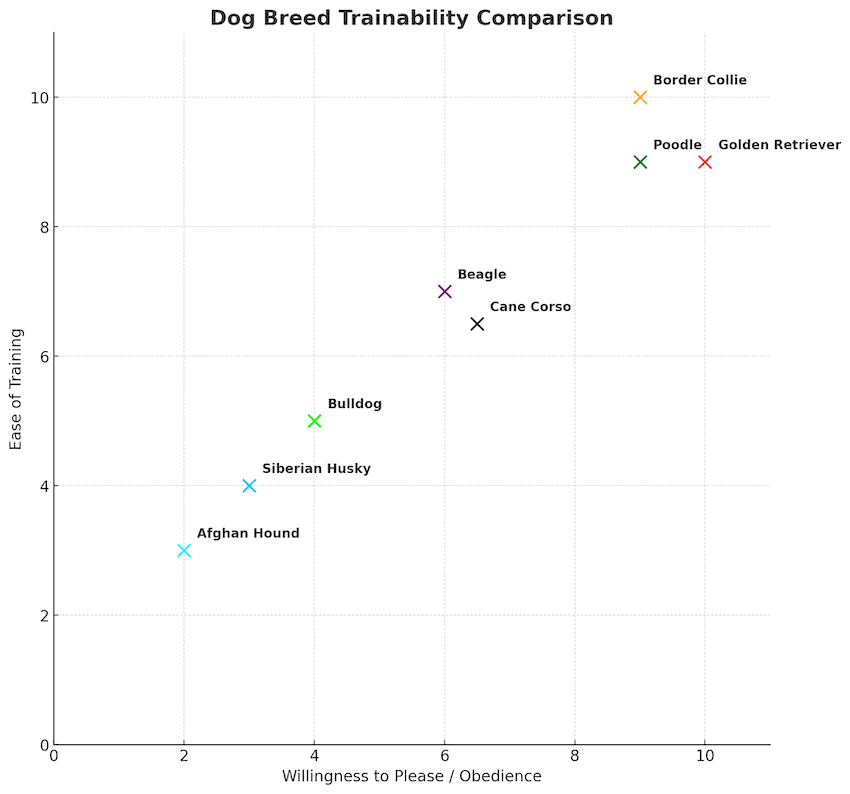
Intelligence
According to canine psychologist Stanley Coren (author of The Intelligence of Dogs – View on Amazon), dog intelligence can be broken down into three types:
- Instinctive Intelligence – What a dog is bred to do (herding, guarding, retrieving).
- Adaptive Intelligence – A dog’s ability to solve problems and learn from the environment.
- Working & Obedience Intelligence – How quickly a dog learns commands and obeys them.
IQ Comparison
Cane Corsos are known for their measured intelligence and calm confidence, especially in environments where structure, leadership, and purposeful engagement are provided. Though not flashy in their learning style, they perform well in working-dog IQ studies for their ability to grasp complex tasks and respond to consistent training. Their focused minds and willingness to serve make them excellent at obedience work, protection training, and structured routines, often thriving in roles that require discipline and reliability.
Cane Corsos excel when training is tied to meaningful tasks. While their dominant nature can be a challenge for inexperienced owners, they’re highly capable learners with the right guidance and boundaries. Their steady focus and sharp instincts allow them to stand out among working breeds for their trainability and problem-solving skills.
Dog Breed Intelligence Comparison
Breeding
Cane Corsos are valued for their strength, loyalty, and protective instincts. Like many purebred dogs, however, they can be prone to inherited health conditions such as hip and elbow dysplasia, bloat (GDV), cardiomyopathy, cherry eye, entropion, hypothyroidism, and skin issues. This makes responsible breeding essential. Ethical breeders should perform health screenings and genetic testing to help reduce the risk of passing on serious conditions. Proper spacing between litters is important to protect the health of both the dam and the puppies, and only physically sound, mentally stable Cane Corsos should be bred.
- Age: Cane Corsos should not be bred until they are fully mature—typically between 24 and 30 months of age.
- Litter size: A typical Cane Corso litter includes 4–10 puppies.
- Temperament: Breeding dogs should have sound temperaments—stable, confident, and obedient, without signs of aggression, extreme dominance, or fearfulness.
Is The Cane Corso A Good Family Dog?
If the conditions below align with your lifestyle, personal preferences, and living situation, a Cane Corso could be a wonderful pet for your family. Otherwise, you may want to consider other breeds.
✅ = Ideal / Strong Match | ⚠️ = Needs Consideration | ❌ = Not Recommended
| Suitability | Category | Score (1–10) | Notes |
|---|---|---|---|
| ✅ | Family Bonding | 9 | Highly loyal and protective; forms strong bonds with family. |
| ⚠️ | Child Friendliness | 6 | Better with older children; early socialization recommended. |
| ⚠️ | Good With Other Pets | 5 | Can be territorial; may not tolerate unfamiliar animals. |
| ⚠️ | Maintenance Level | 5 | Low grooming needs but requires regular ear and skin checks. |
| ⚠️ | Monthly Expenses | 7 | Large size increases food and medical costs. |
| ❌ | Home Size Compatibility | 3 | Not ideal for apartments; needs space to move and patrol. |
| ✅ | Lifestyle Match | 8 | Great for active owners with structured routines. |
| ⚠️ | Trainability | 6 | Intelligent but strong-willed; requires experienced trainer. |
| ⚠️ | Alone Time Tolerance | 5 | Can be destructive if left alone too long or under-stimulated. |
| ⚠️ | Shedding & Drool Level | 6 | Sheds moderately; can drool especially after eating or drinking. |
| ❌ | Hypoallergenic | 2 | Not hypoallergenic; sheds and drools. |
| ✅ | Protectiveness | 10 | Natural guardian; protective instincts are very strong. |
| ⚠️ | Mental Stimulation Needs | 7 | Needs consistent training, structure, and purpose-driven tasks. |
| ⚠️ | Climate Tolerance | 6 | Handles cold well; sensitive to extreme heat. |
| ⚠️ | Life Expectancy | 5 | Average lifespan is 9–12 years. |
| ⚠️ | Barking Level | 5 | Not excessive, but will alert and warn when needed. |
| ⚠️ | Travel Friendliness | 4 | Size and temperament make travel challenging without planning. |
| ⚠️ | Potty Training Ease | 6 | Generally trainable with consistency and leadership. |
Average Score: 6.33 / 10
Annual Cost of Ownership
| Category | Estimated Annual Cost (USD) |
|---|---|
| Food & Treats | $600 – $1,000 |
| Routine Vet Care | $400 – $700 |
| Vaccinations & Preventatives | $250 – $500 |
| Pet Insurance | $400 – $800 |
| Grooming | $150 – $300 |
| Training & Socialization | $300 – $700 |
| Toys & Enrichment | $100 – $200 |
| Supplies (bed, bowls, leash, etc.) | $150 – $300 |
| Emergency Vet Fund (recommended) | $500 – $1,000 |
| Boarding or Pet Sitting | $300 – $600 |
$3,150 – $6,100
Best Places to Get A Cane Corso
Online marketplaces: For pre-screened, healthy puppies, Pawrade and PuppySpot are recommended resources, offering puppies from reputable U.S. breeders.
Rescue shelters: While Cane Corsos are rarely available at local shelters, opportunities can occasionally arise. Check your local animal shelters or dog rescue organizations for information. Online communities, such as Facebook groups, can also be helpful resources.
Breeders: Finding a reputable Cane Corso breeder can be challenging due to the complex nature of breeding this large, purebred working dog. Start by searching locally within your state. You may need to travel out of state if local options are unavailable. If purchasing from a breeder further away, consider the possibility of shipping the puppy if pickup is not an option. It’s essential to request medical records and health certifications for both parents. The Cane Corso Association of America’s approved breeder list is a trusted resource for finding ethical breeders.
Avoid breeders who:
- Don’t provide health clearances for both parents
- Don’t allow visits to meet the dogs or see their living conditions
- Have frequent litters with no waiting list
- Emphasize appearance over health and temperament
Sources
Canine Bible authorship represents the unified voice of our entire editorial team and our in-house veterinarians rather than a single author. Each article, blog post, and review published under the Canine Bible name undergoes a rigorous review process, involving all team members to guarantee accuracy and up-to-date in accordance with the latest veterinarian research. This collaborative effort is an integral part of our editorial process and aligns with our four pillars of content creation. This approach ensures our content is backed by expert knowledge and factual information, offering our readers reliable, actionable, and trustworthy content.



